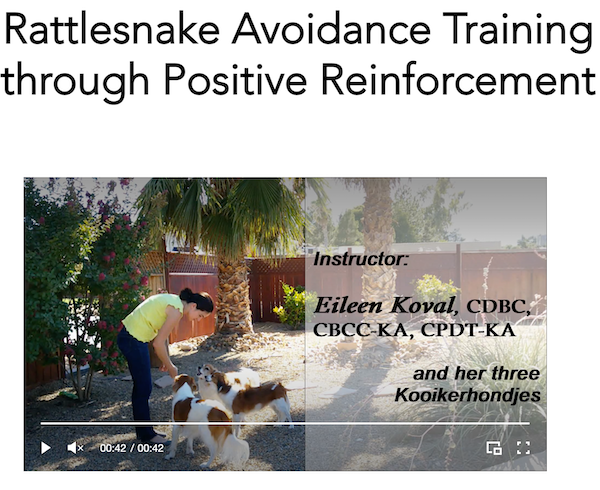If you know or suspect your pet has been bitten by a snake, whether it is a poisonous one or not, seek veterinary care immediately.
I am among the one-third of adult humans who have a fear of snakes. It doesn’t matter if they are alive or dead, I freak out – literally.
Our four-legged companions don’t typically have a fear of snakes, but rather, they have a curious and playful attitude about them. This is why they end up getting bitten.
Each year, between 150,000 and 300,00 animals are bitten by pit vipers in the U.S.
Unless you and your pet live in Alaska or Hawaii, where there are no snakes, there is a chance your pet may encounter and be bitten by a snake at some point in their life.
It is important to know what to do and what not to do in case your pet is bitten.
What to Do (and Not Do) if Your Pet Is Bitten by a Snake
Here are the steps to take that will help your pet, as well as those to avoid.
Do’s:
-
Seek veterinary care as soon as possible to prevent serious side effects. If the snake is poisonous, antivenom must be administered in a timely manner to block the effects of the snake venom.
-
Keep calm since your pet reacts to your emotions.
-
Keep your pet as calm and quiet as possible.
-
Carry your pet instead of having them walk to help minimize the spread of the venom.
-
If safe, take a picture of the snake so that it can be identified accurately.
Don’ts:
-
Delaying veterinary care isn’t an option. The ‘wait and see’ approach can put your pet at risk.
-
Avoid trying any old wives' tales about snake bites such as tying off the affected area, cutting the bite site, or sucking on it to remove venom.
-
Do not use home remedies for snake bites.
-
Do not apply ice or hot packs.
-
Do not administer any medications at home.
-
Leave the snake alone. DO NOT attempt to catch or kill the snake.
If treatment is delayed only a few hours after a venomous snake bite, the risk of death increases significantly.

Recognizing the Signs of a Snake Bite
Unfortunately, we don’t always witness our pets being bitten. Therefore, recognizing the signs when a snake has bitten your pet is important.
The following are potential signs your pet has been bitten by a snake:
- Sudden yelping from pain when in an area where a snake could potentially be
- Puncture marks in the skin
Ttypically two distinctive puncture wounds are often left by venomous snakes. The distance between fang marks vary based on the species of snake. The puncture marks from non-venomous snakes are smaller, shallower, and less defined and may appear as a scratch.
- Redness or swelling of the skin
- Swelling of the face, leg, or chest
- Drooling
- Dilated pupils
- Pale gums
- Increased respiratory rate
- Increased heart rate
- Weakness
- Collapse
- Paralysis
Factors That Affect the Degree of Damage from Snake Bites
The severity of damage caused by a snake bite is based on several factors:
-
Your pet's age, size, and overall health status
-
Species of snake
-
Size of the snake
-
Age of the snake – Adult snakes, compared to juvenile snakes, have a larger venom volume, and when they bite, they can deliver more venom.
-
Where the bite was inflicted and how deep it was:
-
Bites inflicted in locations with a rich blood supply, such as the lips, nose, or tongue, are more serious than the bites on a leg with a poorer blood supply. Bites to the tongue can be deadly.
-
Bites to the head and neck can cause serious swelling and make it difficult for pets to breathe.
-
-
How much venom was injected
-
How much time elapsed between the bite and veterinary treatment
-
Compared to dogs, cats are more resistant to the effects
Why Medical Care Is Essential For Non-Poisonous Snake Bites
Most people only feel that a snake bite is dangerous to pets if the snake is venomous. While bites from venomous snakes generally have more serious effects, such as causing extensive tissue damage or blood clotting issues, non-venomous snake bites can cause complications for pets as well.
Non-venomous snake bites can cause swelling, bruising, and pain.
A snake’s mouth contains a variety of bacteria. That bacteria can enter a bite wound, causing an infection. This can be especially dangerous if an immune-compromised pet is bitten.
It is important that your veterinarian assess any snake bite your pet receives so that the wound can be properly cleaned and the necessary medications, such as pain meds and/or antibiotics, can be prescribed.
How Venomous Snake Bites Are Treated
When a cat or dog receives prompt treatment after being bitten by a venomous snake, the prognosis is better compared to those that have delayed treatment. Even if treatment is delayed only a few hours, the risk of death increases significantly.
The risk of more serious complications is greater for small dogs and cats.
Most pets are hospitalized for at least a day or more for supportive care and observation.
Treatment for Venomous Snake Bites Includes:
Antivenom:
The reason it is beneficial to know the type of snake that has bitten your pet is because the antivenom is specific for each type of venomous snake. However, antivenom is not available at all veterinary clinics, but it is still possible for many pets to recover without it.
Antivenom is expensive and can cost $600 to $1000 per vial. For example, an average of 1 to 20 vials may be needed for a dog, based on their size and the type of snake bite.
A pet can have an allergic reaction to antivenom, which is another reason why hospitalization is an essential part of care.
Intravenous fluids:
Fluids are essential to help maintain blood pressure, flush out toxins, treat shock, and maintain hydration.
Pain medications:
Snake bites are painful, and pain medications are essential to alleviate any discomfort. Depending on the severity of the bite and how well the pet responds to treatment, pets may need pain medications anywhere from a few days to a couple of weeks.
Other medications :
If your pet is suffering from shock or your veterinarian is concerned about infection, additional medications such as steroids, antihistamines, and antibiotics may also be given.
How to Avoid Bites
Know Snake Behavior
Snakes tend to be more active when temperatures are warmer and hibernate when temperatures drop (winter).
During the spring and summer months, their peak activity tends to be early in the morning and around dusk when the day is cooler. Activity declines during the hottest parts of the day. This is critical to understand because morning and dusk are the times we recommend walking dogs to prevent them from overheating, which means your chances of coming into contact with a snake are increased.
Snakes are active in the fall as they are preparing for hibernation and looking for food and a den. Therefore, be vigilant when on walks or hikes, especially near tall ground cover.
Snakes can be diurnal (active during the day), nocturnal (active at night), or crepuscular (active at dawn or dusk). Know when the snakes in your state are most active. See this interactive chart for the types of snakes in your state. States are also ranked by snake population in this chart.
Control the Environment
In addition to understanding how snakes behave to avoid your pet being bitten, here are some other steps you can take to protect your pets.
-
Stay away from places where snakes like to hide, such as dense grass and rocky formations.
-
Keep your pets (cats too!) on a leash when on walks or hikes.
-
Create a snake-proof yard:
-
Eliminate or minimize hiding places, such as wood or leaf piles
-
Keep the grass trimmed close
-
Reduce food sources by keeping rodents under control
-
Eliminate moisture, such as standing water, birdbaths, etc., since snakes are attracted to it
-
Use pine bark mulch instead of pine straw
-
Store firewood away from your house or pet areas
-
Keep shrubs trimmed
-
Train Snake Avoidance
For details on what to do if you want to train your dog yourself, check out our article on how to teach your dog to avoid snakes. For professional training help, see our certified trainer's recommendation for a virtual snake avoidance course.
MY EXPERIENCE WITH VIRTUAL SNAKE AVOIDANCE TRAINING by Cathy Madson, CBCC-KA, CPDT-KA
Finding snake avoidance training can be tough! And trying to find a training course that doesn't rely on aversives like shock collars is even harder.
I'm excited about this great virtual option from Eileen Koval of Confident Canines. While I don't live in snake country (where I am, garter snakes are about all we've got), I wanted to learn the best techniques for snake avoidance in case I ever received this request from my own training clients. Eileen lives in Nevada and offers a virtual snake avoidance course for anyone, anywhere in the world.
I worked through this course and was happy to see a comprehensive curriculum and easy-to-follow instructional videos. Not only does Eileen teach the why behind the training, but she also makes sure you know what materials you'll need and gives you tips on how to find them. Who knew that you could find snake sheds for purchase to use for training exercises!
You'll learn how to train your dog to automatically avoid snakes based on smell, sight, and sound – whether or not you're close by. I also loved how the course covers intelligent disobedience, where a dog learns to ignore cues they get from us to move forward if there is a snake. This is so important, as we humans will often not be able to smell a snake and could inadvertently send our dogs into danger.
This course uses only positive reinforcement techniques and focuses on building reliable obedience skills and a strong relationship between handler and dog. I can't recommend it enough for anyone looking to train their dog to avoid snakes!
Overall Rating: 5 out of 5 stars ⭐⭐⭐⭐⭐
Sign Up for Eileen's Snake Avoidance Course Here
Note: We were not compensated or influenced in any way to produce this review.
Know Your State’s Snakes
It is helpful to know which venomous and non-venomous snakes live in your state and how to identify them. See this interactive chart for the types of snakes in your state.
Being able to identify the type of snake that bit your pet can significantly help your veterinarian provide the appropriate treatment and determine if antivenom is needed or not.
It is important to keep in mind that snakes are extremely beneficial to the environment. That is why there are different laws and regulations protecting them. So, you may want to think twice before just killing a snake.
Story Time
I would like to end with an embarrassing story. I only tell it to prove how important it is to be constantly vigilant when you are in areas where snakes live.
It was a beautiful day during Labor Day weekend. My family decided to go on a hike around a nearby reservoir.
As you can imagine, being a holiday weekend, the area was busy with people hiking, fishing, biking, and boating. The amount of foot traffic on the trail was immense.
I walked the whole path with my eyes glued to the ground. As we were on our way out on the heaviest-traveled and widest area of the path, I became distracted by a lady fly fishing. It was mesmerizing to me how graceful the whole process looked, but I continued walking.
Suddenly, I felt something under my foot, knowing immediately what it was – A SNAKE! It bit me and I instantly leapt in the air (some say at least 10 feet!) and screamed so loud it was likely heard for miles.
I turned to see the snake because I feared it was a rattlesnake, since the reservoir is nicknamed Rattlesnake Lake.
At first glance, it appeared to be a rattlesnake, but I was fortunate that it was a non-venomous Bull snake, which can have a similar pattern, especially to someone who was in a state of panic.
So, the lesson is ALWAYS pay attention to your surroundings, and if you get distracted by the beauty that surrounds, stop and take it in.
I hope you and your pets always stay safe and enjoy the outdoors.







